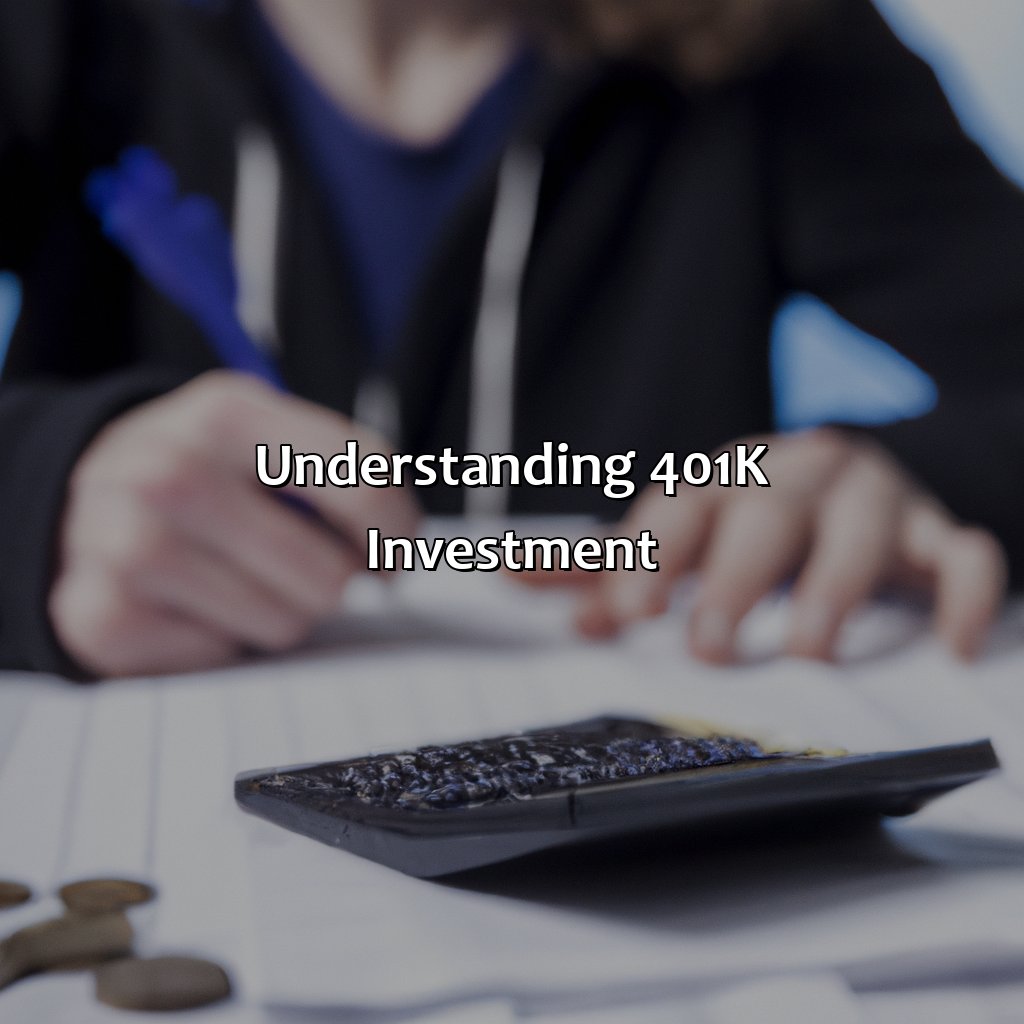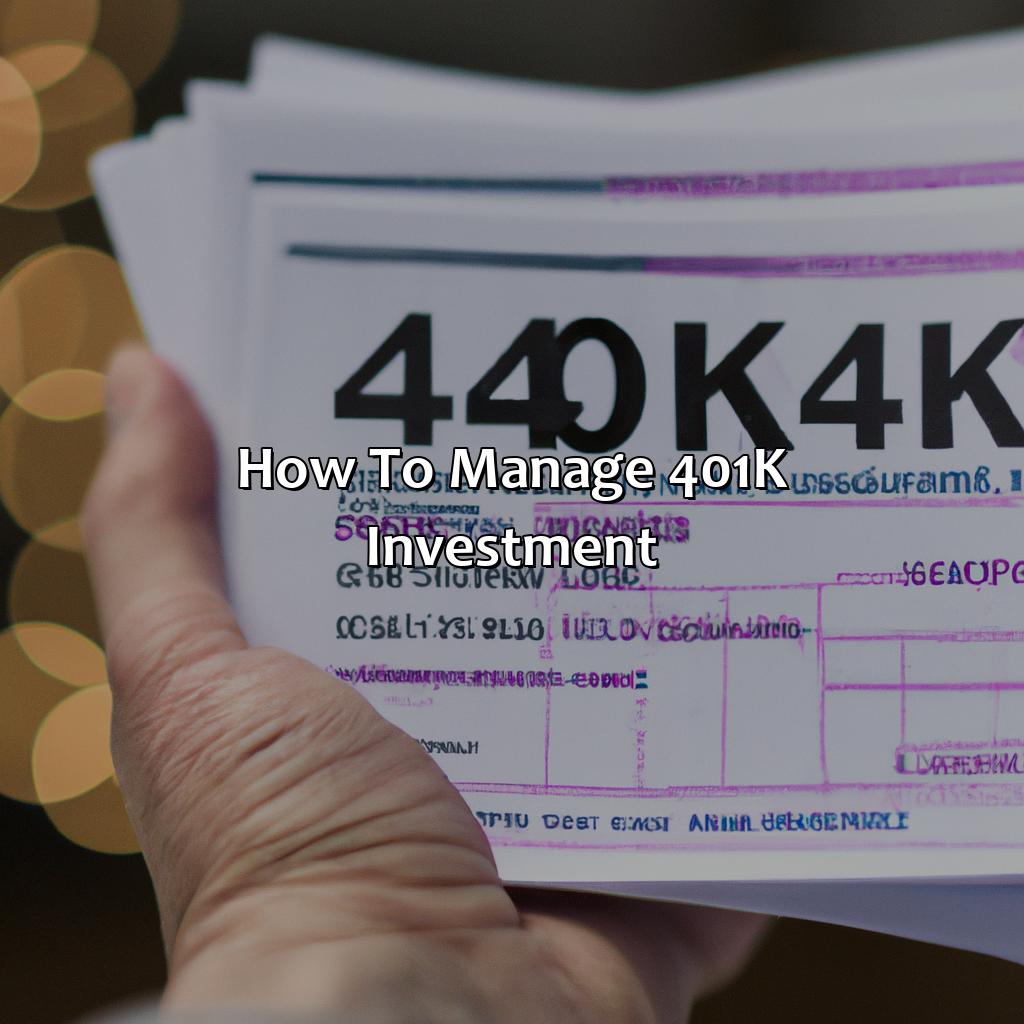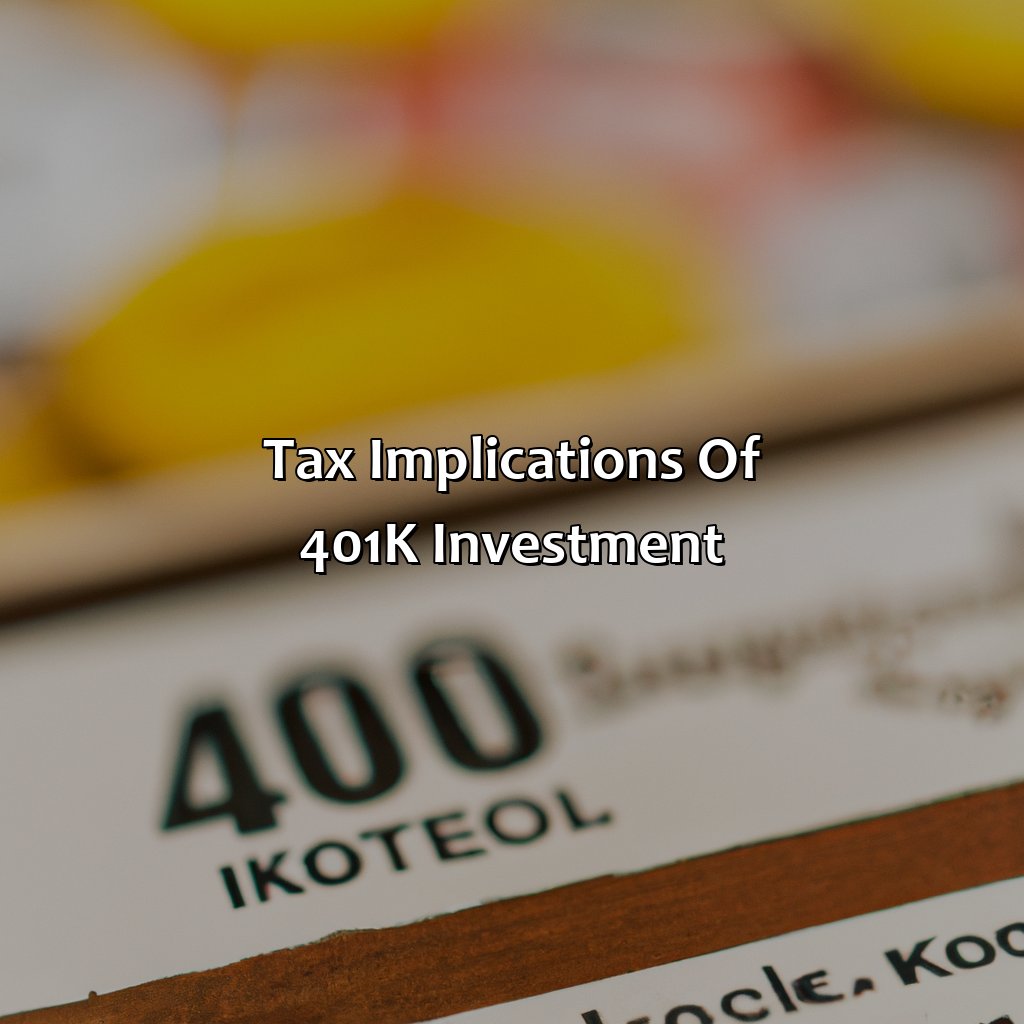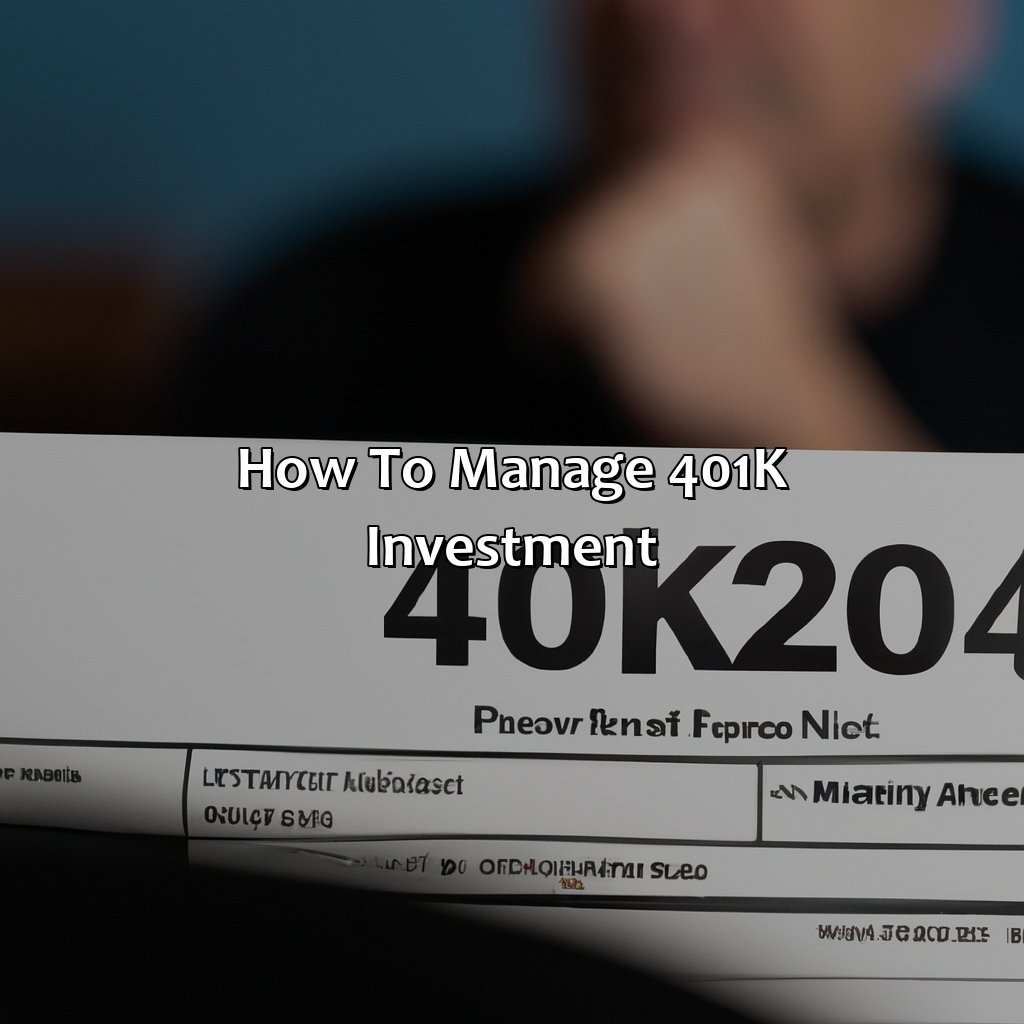How To Manage 401K Investment?
Key Takeaway:
- Understanding 401k investment is crucial: A 401k is a retirement savings plan that offers tax benefits and compound interest. It’s important to understand how it works and to learn about the types of 401k plans available.
- Managing 401k investment requires setting goals and choosing investment options: Determining investment goals and risk tolerance is crucial in managing a 401k portfolio. Choosing investment options that align with these goals and monitoring the portfolio regularly can help ensure success.
- Knowing the tax implications of 401k investment is essential: While a 401k offers tax advantages, there are withdrawal rules and penalties to consider. Understanding these tax implications can help individuals plan for retirement more effectively.
Are you unsure of how to maximize your 401k investments? You can take control of your retirement savings and use simple strategies to maximize returns and achieve your long-term financial objectives. This article will provide you with the guidance you need to manage your 401k investments.
Understanding 401k investment
Explore our “Understanding 401k Investment” section to make the most of your retirement savings. Begin with “What is 401k Investment?” and “Types of 401k Plans”. Get to know the basics of 401k investment. Check out the different plans available!

Image credits: retiregenz.com by Adam Jones
What is 401k investment?
A 401k investment is a tax-advantaged retirement savings account offered by employers in the USA. Employees contribute a portion of their earnings, which are automatically deducted from their paychecks and invested in funds of their choosing. The funds grow tax-deferred until withdrawal during retirement.
To manage a 401k investment, employees should start by determining their risk tolerance, age, and retirement goals. They should then research and select appropriate investment options based on factors such as past performance, fees, and diversification. Regular monitoring and rebalancing can help maintain a balanced portfolio aligned with long-term objectives.
It’s important to note that 401k investments are subject to market fluctuations and may be affected by economic conditions. Employees should regularly assess their accounts’ performance and make adjustments as needed to stay on track towards achieving retirement goals.
An average annual return of 7% over the long term may help an employee’s portfolio reach $1 million by retirement with regular contributions and consistent management (Forbes).
Getting to know the different types of 401k plans is like trying to understand a foreign language, but with a hint of investment banking jargon thrown in for good measure.
Types of 401k plans
401k Plan Variations and Their Features
Different types of 401k plans exist that vary based on their features, benefits and eligibility criteria. Let’s explore some possible 401K plan variations.
- Traditional 401k Plan: Pre-tax contributions are made with tax-deferred earnings growth until the withdrawal of funds during retirement.
- Roth 401k Plan: After-tax contributions yield tax-free withdrawals when taken out during retirement years.
- Solo-401k Plan: Eligible only for business owners who don’t have employees other than a spouse. The plan allows for greater contribution limits from the employer and employee.
- Safe Harbor 401k Plan: Designed to provide smaller and mid-sized companies with additional flexibility through mandatory annual employer contributions, Matching options or non-elective contribution methods instead.
- Simple 401k Plans: Suited for small businesses to offer an affordable alternative to traditional 401(k) plans by enabling employers and employees to make contributions effortlessly without minimum contribution requirements.
- Automatic Enrollment Safe Harbor 401(k): Employer-sponsored Retirement Saving Plans which automatically enroll eligible employees in terms’ of age-binding provisions escalating over time periodically renewable by opting-out method.
It is essential to understand the individual advantages, eligibility prerequisites, contribution limits (2021), distribution processes, loan options, vesting schedules and other factors in detailed manner before selecting a suitable plan altogether.
Pro Tip: Always analyze available investment options based on risk tolerance, diversification rules and industry benchmarks while monitoring rebalancing portfolio regularly.
Managing your 401k investment is like taking care of a pet – it needs attention, regular check-ups, and a lot of love (aka money).
How to manage 401k investment
For your 401k investment success, begin by setting goals and your risk level. Then, pick investment options that fit them. Finally, to get the most out of your 401k, keep an eye on it and make changes when needed.

Image credits: retiregenz.com by David Woodhock
Setting investment goals and risk tolerance
When it comes to managing your 401k investments, it’s crucial to set clear objectives and determine your risk tolerance. Developing investment aims that align with your long-term financial goals is essential. Additionally, understanding your risk tolerance can help you strike a balance between risk and returns.
To set investment goals and determine your risk tolerance, assess your current financial situation, consider personal and professional aspirations, and evaluate past experiences. Creating an investment plan that considers these factors ensures that you remain focused on achieving each objective while sticking to a level of investment risk you’re comfortable with.
To identify your investment objectives and level of risk tolerance, communicate with a financial advisor or tax professional who understands 401k investments’ complexities. They’ll guide you through the process using their expertise and help select the right portfolio mix for you.
With adequate knowledge of managing 401k investments, we suggest diversifying asset classes across bonds, stocks, and real estate trusts. Each asset class has unique characteristics that mitigate overall portfolio risks. Regular checking balances are vital as well as staying informed about market trends that affect retirement savings.
Choosing the right investment options is like picking a flavor of ice cream – you want something that’s both delicious and won’t give you brain freeze.
Choosing investment options
When managing your 401k investment, it’s important to carefully consider the options available to you. Here are some key takeaways:
- Review investments regularly to ensure alignment with personal goals.
- Consider diversifying investments across different asset classes and risk levels.
- Choose funds with low expense ratios and fees.
- Avoid investing in employer stock, unless it is part of a diversified portfolio.
- Seek professional advice when needed, but be mindful of fees and conflicts of interest.
It’s crucial to remember that investment options can vary significantly based on individual circumstances. Factors such as age, risk tolerance, financial goals, and market conditions should all be taken into consideration.
When making investment decisions, keep in mind that there is no one-size-fits-all approach. It’s important to evaluate which investments align with your financial objectives and make changes as necessary over time.
To maximize returns while minimizing risk in a 401k investment portfolio, individuals should consider choosing a mix of stocks and bonds that suits their financial profile. By maintaining a diversified portfolio of options through various asset classes like large-cap stocks or fixed income bonds with differing levels of risks one can reach their ultimate retirement goals.
To summarize, it’s essential for individuals to understand the various investment options available when managing their 401k effectively. By diversifying investments strategically and reviewing regularly aligning their portfolio risks & rewards with long term financial ambitions will help them achieve optimal results over time.
It’s like playing Jenga with your retirement savings, but instead of wooden blocks, it’s your portfolio and instead of bad moves, it’s the stock market.
Monitoring and adjusting the 401k portfolio
Keeping a watchful eye on the performance of your 401k investments and making refined adjustments periodically can secure reliable returns. Regular assessment of the 401k portfolio is imperative for ensuring that it remains in sync with your investment goals while maintaining an appropriate balance between risk and reward.
To make sure that you are managing your 401k investments appropriately, keep track of how your allocated funds are performing. You can evaluate their growth rate or yield against benchmarks, like market indices, and adjust your portfolio whenever you find it necessary. Also, stay informed about any updates made by the fund managers regarding asset allocation strategies so that you can make informed decisions on behalf of your long-term interests.
In addition to monitoring your 401k investment’s performance, you should also keep a lookout for unfavorable news related to the specific companies or industries included in them. By keeping yourself updated with recent developments concerning the economy or any company whose equity is included in one of your fund’s portfolios will give you an improved understanding of where the industry is headed.
Ensure to continually review and analyze market factors when making changes to a 401k retirement plan by striking a balance between conservative and aggressive options based on what best fits an individual’s financial goals over time and risk tolerance. Diversification of assets will help manage risks while allowing optimal portfolio growth over time.
Watch out for taxes, they have a way of taking a bigger bite out of your 401k investments than you planned.
Tax implications of 401k investment
Maximize tax benefits and reduce fees & penalties with your 401k investment! To do so, understand the special tax advantages of 401k investment. Additionally, be aware of the withdrawal rules & penalties. Consider these two aspects while managing your 401k. This will help you handle contributions & withdrawals in the best way possible.

Image credits: retiregenz.com by Adam Woodhock
Tax advantages of 401k investment
One of the most noteworthy benefits of investing in a 401k plan is the tax advantages it offers. Contributions to your retirement account are pre-tax, meaning they lower your taxable income and reduce your overall tax liability. Additionally, earnings on investments in a 401k account grow on a tax-deferred basis until you withdraw them at retirement age.
These benefits allow your savings to compound over time without being depleted by taxes on investment gains or withdrawals from the account. Furthermore, 401k contributions may also make you eligible for additional tax credits or deductions, depending on your income level and circumstances.
It’s important to consider how the tax implications of your 401k investments will affect your retirement goals and overall financial plan. Calculating your necessary contribution amounts and understanding any potential penalties for early withdrawals can help you effectively manage your investments and maximize their tax advantages.
To optimize these benefits, experts recommend maximizing annual 401k contributions, taking advantage of any employer matching programs, and diversifying investment choices within the account. By staying informed about tax laws and regulation changes related to retirement accounts, you can ensure that you are taking full advantage of available deductions and credits while building wealth for the future.
Looks like taking out your 401k early is about as wise as drinking bleach instead of paying taxes – both will leave you feeling pretty sick.
Withdrawal rules and penalties
When considering the disbursement regulations and penalties, it is essential to know that withdrawals from a 401k before the age of 59½ frequently carry a ten percent early withdrawal fee. Additionally, the amount withdrawn may be subject to federal and state taxes.
In addition, there are particular conditions under which you may avoid these charges or circumstances in which you are permitted to withdraw from the account without penalty. Such circumstances include permanent disability or making compulsory minimum payments after the age of 72 years (RMDs).
It is also vital to remember that penalties can range based on the kind of retirement account, whether it is traditional or Roth. As a result, individuals must conduct their research to determine which protocol would work best for their unique case.
One approach to avoid unnecessary disbursement charges is to manage your retirement contributions judiciously by assessing how much money you anticipate needing later in life and limiting expenditures that could induce issues if they require liquidating your retirement funds.
Overall, managing 401k investments is critical as it can significantly affect your future financial wellbeing. To make informed choices regarding early withdrawals, individuals should seek counsel from a trained professional who can evaluate their situation and offer tailored advice.
Five Facts About How To Manage 401k Investment:
- ✅ A 401k is a retirement savings plan sponsored by an employer in which employees can contribute a percentage of their salary. (Source: IRS)
- ✅ Many employers offer matching contributions up to a certain percentage of the employee’s contribution to the 401k plan. (Source: Investopedia)
- ✅ It is important to regularly review and rebalance your 401k portfolio to ensure it is aligned with your financial goals and risk tolerance. (Source: The Balance)
- ✅ Consider diversifying your 401k investments by allocating funds across different asset classes, such as stocks, bonds, and real estate. (Source: NerdWallet)
- ✅ Depending on your financial situation and retirement goals, it may be beneficial to consult a financial advisor when managing your 401k investments. (Source: U.S. News & World Report)
FAQs about How To Manage 401K Investment?
What is a 401k investment?
A 401k investment is a retirement savings plan that is sponsored by an employer. It allows employees to contribute a portion of their salary to the plan, which is then invested in a range of funds. The money in the plan is tax-deferred until it is withdrawn in retirement.
How do I manage my 401k investment?
You can manage your 401k investment by adjusting your contribution amount, selecting investment options, and monitoring your portfolio. It’s important to regularly review and rebalance your investments to ensure they align with your retirement goals.
What are some tips for managing a 401k investment?
Some tips for managing a 401k investment include diversifying your portfolio, paying attention to fees, and avoiding short-term market timing. You should also consider your time horizon and risk tolerance when making investment decisions.
What happens to my 401k investment if I leave my job?
If you leave your job, you can usually rollover your 401k investment into an IRA or a new employer’s retirement plan. Alternatively, you have the option to leave it with your former employer, but you may be subject to fees and limited investment options.
How much should I contribute to my 401k investment?
The amount you should contribute to your 401k investment depends on your financial situation and retirement goals. Financial experts generally recommend contributing at least enough to receive the full employer match, and increasing contributions as you are able.
What are the tax implications of a 401k investment?
The money you contribute to your 401k investment is tax-deferred, meaning you do not pay taxes on it until you withdraw it in retirement. Once you begin taking withdrawals, they are taxed as ordinary income. Additionally, there are penalties for early withdrawals before age 59 1/2.
